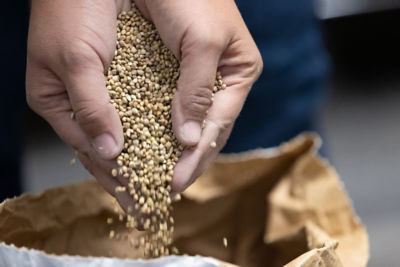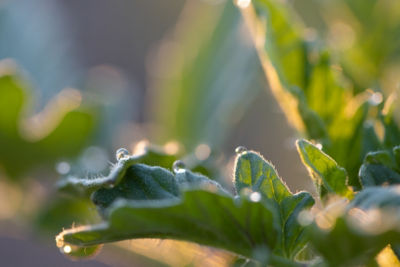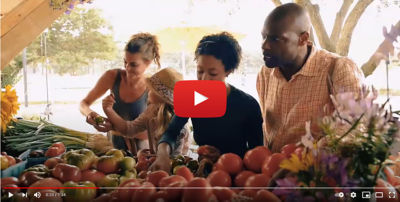Click here to download a PDF version of this spotlight.
» Phytophthora blight of watermelon includes infections of the roots, crowns, stems, leaves, and fruit.
» When severe, Phytophthora blight can result in a complete loss of fruit production and death of the plant.
» Integrated programs using cultural and chemical control strategies can help manage Phytophthora blight on watermelon.
Pathogens in the genus Phytophthora cause several diseases of watermelon, including damping-off, root rot, crown rot, foliar blight, and fruit rot. Sometimes, the term Phytophthora blight is used to refer to any of these diseases.1,2 Phytophthora belongs to the oomycete (water mold) group of fungal-like organisms. The species Phytophthora capsici is the most common cause of Phytophthora blight, but other Phytophthora species are sometimes involved. Phytophthora capsici can infect watermelon plants at any stage of development and can result in a range of symptoms.
Root rot, crown rot, and foliar blight can reduce yield potential by slowing plant growth and reducing the number of fruit produced, if not killing the plant outright. Fruit rot attacks the harvested product directly, making the fruit non-marketable. Moderate to high levels of fruit rot can result in total crop loss because of the difficulty of selectively harvesting non-infected fruit.1,2 Phytophthora blight is more common on summer and winter squash, but almost all cucurbit crops are susceptible to the disease. Other crop species, including tomato, pepper, and legume crops, are also hosts of P. capsici.1,2
SYMPTOMS
Initial symptoms of crown and root rot include the affected tissues becoming water-soaked, soft, and turning tan to brown to black (Figure 1). Leaves and stems show a sudden and permanent wilt, initially without a color change. The leaves and stems can turn brown and die within a few days of symptom development.1,3 In some cases, the entire root system rots. Dark brown lesions sometimes develop on the leaves.
The fruit rot phase typically starts on the parts of the fruit that are in contact with the soil. Initial symptoms include the development of water-soaked lesions. These lesions can also develop on the upper fruit surface from inoculum splashed onto the fruit by rain or overhead irrigation. Fruit infections can occur at any time from fruit set through harvest.2,4 The lesions are several inches in diameter and often become covered with a white fungal growth, sometimes described as having a “powdered sugar” appearance (Figure 2). This growth includes masses of sporangia (spore-forming structures), and the growth can completely cover the fruit under moist conditions. Infected fruit rot rapidly, and they collapse entirely within a few days.2,3,4,5 Symptoms may develop on the crown, stems, and leaves before appearing on the fruit.
CYCLE AND CONDITIONS
Phytophthora capsici overwinters in infested crop debris, as spores in the soil, and on the roots of some weed species. Phytophthora spores can remain viable in the soil for over ten years. The pathogen has a wide host range, including other crop and weed species. The pathogen is spread by the movement of spore-like structures called sporangia, mostly in splashing and flowing water. Sporangia can germinate and produce hyphae that directly infect the plant, or they can release 20 to 40 swimming zoospores that can move in films of water on plant surfaces before infecting the plant, increasing the number of infections resulting from one sporangium.1,2
Disease spread and development are favored by warm (77°F, 25°C) and wet conditions. Overhead irrigation, rainfall, high relative humidity, and sites with poorly drained soils all contribute to increased disease severity. The disease is often most severe in low-lying areas of the field, where the soils remain saturated for extended periods. Dispersal patterns often follow paths of water drainage in the field, usually preading along rows faster than across rows.1,2 Some studies have reported a higher incidence of fruit rot later in the season, giving rise to speculation that older fruit may be more susceptible to infection by Phytophthora. However, a study specifically looking at the effects of fruit age on susceptibility found that fruit are equally susceptible at all ages, and fruit rot levels were not correlated to fruit sugar content.6
MANAGEMENT
Phytophthora diseases on watermelon can be difficult to control once the pathogen is established in the field. The initial management strategy is to prevent the introduction of the pathogen by sanitizing equipment, tools, and other items on which soil can be moved before entering non-infested fields. If the farm has a mix of infested and non-infested fields, work in the infested fields last, and sanitize the equipment before returning to the non-infested fields. Use clean sources of irrigation water, such as deep wells. Avoid using surface water (ponds) for irrigation because P. capsici can be present in that water. Also, avoid planting in areas with poor drainage.1,2,4
Rotating to non-host crops can help lower inoculum levels, but because the pathogen can survive for at least ten years, rotation will not be sufficient for managing the disease on its own. An integrated program (IPM) of cultural and chemical practices will usually provide the best results in managing the disease. Cultural practices that can lower disease incidence and severity include avoiding overhead irrigation and proper irrigation scheduling to prevent extended periods of saturated soils. Planting on raised beds, using drip irrigation, and plastic mulch can help promote good soil drainage and keep fruit from coming into contact with the soil, at least for the fruit produced on the bed. This may be less effective for the fruit produced on vines that grow into the inter-bed spaces.1,2,4
Culled fruit should not be dumped in production fields, as that can increase inoculum levels. Scouting fields regularly can help detect localized patches of diseased plants that can be removed and destroyed before the disease spreads more widely. The non-symptomatic plants surrounding the symptomatic plants should also be removed, as they may already be infected. Do not place infected crop debris in production fields. Similarly, promptly removing and destroying infected fruit can help limit disease spread.2,3,4 Healthy fruit should be harvested as soon as it is ready to help minimize infections that will only become apparent after harvest.4
Fungicides should be used as part of a comprehensive IPM program.1 The application of appropriate fungicides can help limit disease development and crop losses, but they may not be able to provide adequate control when conditions are extremely favorable for disease development and spread. Because fruit can be infected at any age, fungicide applications should start by initial fruit set in fields with a history of the disease. It is best to apply fungicides before symptoms of the disease appear. Oomycete pathogens such as Phytophthora and Pythium may not respond to fungicides that are effective against fungal pathogens, so products known to be effective against oomycetes should be used.1,5,6 Fungicides containing the active ingredients cyazofamid, cymoxanil, dimethomorph, fluopicolide, mandipropamid, mefenoxam, oxathiapiprolin, and zoxamide are listed in regional production and pest management guides for helping to manage Phytophthora on cucurbit crops.2,3 Some of these chemicals may be at risk for resistance development by P. capsici. Resistance in P. capsici populations has been confirmed for cyazofamid and mefenoxam.2 When applying fungicides, growers should alternate products with different modes of action to help prevent further resistance development.1 Always follow label directions for information on using pesticides.
Currently, no commercially available watermelon varieties are resistant to the root rot, crown rot, or fruit rot phases of Phytophthora blight. There is research showing that grafting watermelon plants onto resistant rootstocks can provide some control of the disease.2 USDA-ARS scientists have characterized watermelon plant introduction (PI) lines for resistance to Phytophthora fruit rot, and these lines were used to develop germplasm lines that breeders can use to develop commercial varieties with resistance to Phytophthora blight.7 The germplasm lines have been evaluated against twenty P. capsici isolates from multiple states. Three of the lines had broad resistance to all twenty isolates. There was some variation in pathogenicity among the isolates and some differences in how the germplasm lines responded to different pathogen isolates. Races of P. capsici have not been identified on watermelon, but they have been identified on peppers. Therefore, it will be important to identify several sources of resistance in watermelon to help ensure the longevity of using resistance to help manage Phytophthora blight.7
SOURCES
1 Hausbeck, M. and Quesada-Ocampo, L. 2017. Phytophthora crown and root rot. In Compendium of Cucurbit Diseases and Pests, Keinath, A., Wintermantel, W., and Zitter, T. (Editors). The American Phytopathological Society. St. Paul, pp 43-45.
2 McGrath, M. 2017. Phytophthora fruit rot. In Compendium of Cucurbit Diseases and Pests, Keinath, A., Wintermantel, W., and Zitter, T. (Editors). The American Phytopathological Society. St. Paul, pp 102-104.
3 Hausbeck, M. and Linderman, S. 2016. Managing Phytophthora on cantaloupe, muskmelon, and watermelon. Michigan State University Extension.
4 Kicklighter, J. 2016. Phytophthora fruit rot on watermelons. Colquitt County Ag Report. June 28, 2016.
5 Egel, D. 2015. Phytophthora fruit rot of watermelon. Vegetable Crops Hotline, 600.
6 Kousik, C. and Ikerd, J. 2018. Development of Phytophthora fruit rot caused by Phytophthora capsici on resistant and susceptible watermelon fruit of different ages. Plant Disease 102:370-374.
7 Kousik, C., Ikerd, J., Wechter, W., Branham, S., and Turechek, W. 2022. Broad resistance to post-harvest fruit rot in USVL watermelon germplasm lines
ADDITIONAL INFORMATION
Performance may vary from location to location and from year to year, as local growing, soil and weather conditions may vary. Growers should evaluate data from multiple locations and years whenever possible and should consider the impacts of these conditions on the grower’s fields. The recommendations in this article are based upon information obtained from the cited sources and should be used as a quick reference for information about vegetable production. The content of this article should not be substituted for the professional opinion of a producer, grower, agronomist, pathologist and similar professional dealing with vegetable crops.
BAYER GROUP DOES NOT WARRANT THE ACCURACY OF ANY INFORMATION OR TECHNICAL ADVICE PROVIDED HEREIN AND DISCLAIMS ALL LIABILITY FOR ANY CLAIM INVOLVING SUCH INFORMATION OR ADVICE.
5011_167350 Published 01/23/2023




